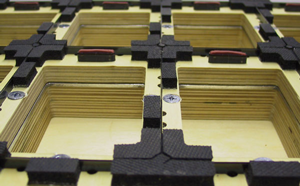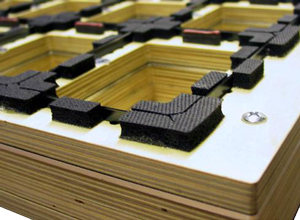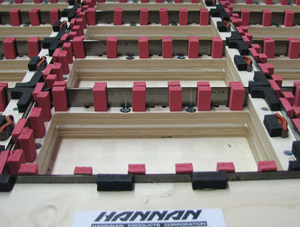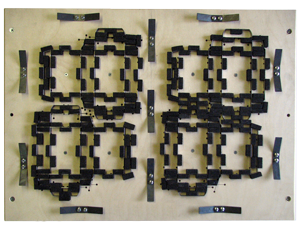



Standard Diamond® Dies
In Stock Ready To Ship
There is much more to creating a useful, long lasting Diamond Die than just inserting some rule in a board. All HANNAN Diamond dies feature the following:
 |
| 3 Pt. point steel rule | 11 Ply Hard Wood |
| Ejection Rubber | Registration Clips for Precise Cutting |
| Cavity Dies | Designed for Long Life |
 |
| HANNAN® Diamond Die: | $390.00 | ||
| 18x24 2 Cards Up/Out "Landscape" |
 |
| HANNAN® Diamond Die: | $460.00 | ||
| 18x24 4 Cards Up/Out "Port" |
 |
| HANNAN® Diamond Die: | $545.00 | ||
| 18x24 8 Cards Up/Out "Landscape" |
 |
| HANNAN® Diamond Die: | $710.00 | ||
| 18x24 16 Cards Up/Out "Port" |
Call For Quote
Toll Free: 800-954-4266
Phone: 951-735-1661
Fax: 951-735-0827
Email: sales@hannanpak.com
© Hannan Products Corporation, All Rights Reserved, "Patent Applied For" |
Made in America |
Phone: 800-954-4266 |

|


Custom Steel Rule
Cutting Dies
 |
| 3 Pt. point steel rule | 11 Ply Hard Wood |
| Ejection Rubber | Registration Clips for Precise Cutting |
| Cavity Dies | Designed for Long Life |
Contact Us
Toll Free: 800-954-4266
Phone: 951-735-1661
Fax: 951-735-0827
Email: sales@hannanpak.com
© Hannan Products Corporation, All Rights Reserved, "Patent Applied For" |
Made in America |
Phone: 800-954-4266 |

|

Hannan Products
Steel Rule Cutting Dies
Language of Steel Rule Dies
Constructed out of high-grade and high-density plywood. The plywood is usually composed out of hard woods and are free from voids. The 3pt. steel rule itself is essentially an elongated razor blade made out of hardened steel. The die-maker cuts and bends the steel rule and positions it into the slits in the substrate.
Creating the die involves the addition of ejection rubber. Rubber pads are adhered to the substrate to help eject the material after it is cut. Without the inclusion of ejection rubber, the material may tend to get stuck to the steel rule.
-
Rule Support : The amount of material keeping the rule upright.
-
Ejection Rubber : How the die helps "eject" your item.
-
Rule Support : The amount of material keeping the rule upright.
-
Cavity Placement : How the cavity (if needed) can be placed without compromising rule support.
What is Steel Rule Die Cutting
Steel rule die cutting is a common process used to cut a range of sheet materials including paper, cardboard, rubber and plastic. Most standard cardboard boxes and packages are made using this relatively straightforward technique. In addition to cutting out shapes, steel rule die can be used to create creases, perforations and slits.
The die is constructed out of a flat base or substrate which is usually made out of high-grade and high-density plywood; the plywood is usually composed out of hard woods such as maple and are free from voids or other imperfections. Some special dies may require aluminum or steel substrates. The die-maker uses a special bandsaw or laser cutter to cut precisely positioned slits into the substrate. The steel rule itself is essentially an elongated razor blade made out of hardened steel. The die-maker cuts and bends the steel rule and positions it into the slits in the substrate.
The final step in creating the die involves the addition of ejection rubber. Rubber pads are adhered to the substrate to help eject the material after it is cut. Without the inclusion of ejection rubber, the material may tend to get stuck amongst the steel rules. The substrate, steel rule and ejection rubber combine to form a steel rule die.
There are all sorts of steel rule. The rule itself comes in a variety of thicknesses that are chosen based on the particular application. There are also several options regarding the cutting edge of the steel rule:
Center bevel - Center bevel steel rule is the most common type of rule and is the most durable configuration. The cutting edge is appropriately centered between the two faces of the rule.
Facet bevel - A facet bevel rule also has a centered cutting edge, but it is shaped more like a diamond and this tends to provide cleaner cuts.
Flush bevel - This type of rule uses a cutting edge that is in line with one of the faces of the rule. The cuts are very clean, but the longevity of this type of rule is poor.
Side bevel - Side bevel rule is rule that has the cutting edge slightly off center. It has good cut quality as well as good longevity.
Once the die maker has completed the steel rule die, it is immediately ready for production. The die is attached to the top platen of a die cutting press that will provide the force required for the job. Smaller presses may provide 20 tons (18,000 kg) of force, whereas larger ones give over 150 tons (135,000 kg)! The material to be cut is positioned below the die and then the press is actuated. If registration is an issue, the material is positioned against a stop or in a locating nest. The cutting edges of the steel rule penetrate through the material until they come into contact with the bottom platen; then the press reverses and the cut part is exposed. In some applications, a softer material is placed below the material to accept the cutting surfaces of the steel rule. When cutting paper, however, the cutting is performed against special steels designed for the purpose.
Perforations and creases are made with special steel rule that is positioned on the same die as the cutting rule. Creases sometimes require secondary dies called a matrix. A matrix is positioned on the opposide side of the press and is aligned with the creasing rule; when configured properly very crisp creases can be created in all sorts of materials. Sometimes heated platens are used when plastic parts are being fabricated to improve the quality of the creases and cuts.
In high-volume die cutting operations, fully automatic machines are used. In these machines, the material to be cut is automatically fed into the press and located in the proper position. The steel rule die is pressed through the material and the pressure is released. The cut piece is removed along with any scrap material, and the next piece is indexed to repeat the process.
Steel rule die cutting can also be used for cutting more exotic materials. Thick foams, carpet and rubber can also be cut with this method. Steel rule die cutting is a relatively inexpensive and effective way of cutting soft sheet goods.
From: www.wisegeek.org/
Standard Diamond® Dies
In Stock Ready To Ship
 |
There is much more to creating a useful, long lasting Diamond Die than just inserting some rule in a board. All HANNAN Diamond dies feature the following:
| 3 Pt. point steel rule | 11 Ply Hard Wood |
| Ejection Rubber | Registration Clips for Precise Cutting |
| Cavity Dies | Designed for Long Life |
Custom Dies
Call For Quote
HANNAN® can create your steel rule die to match your specific requirements and needs -- from simple trim dies to complex multi-unit, cavity, and gasket dies. Steel rule dies can be used to cut, trim, or score numerous materials: chipboard, paperboard, foam, rubber, cork, gaskets, sheet plastic.
HANNAN® will build your steel rule die using the best materials and utilizing our extensive experience. there is so much to be aware of when creating your die.
Our Steel Rule Dies "RULE" TM
 |
Contact Us
Toll Free: 800-954-4266
Phone: 951-735-1661
Fax: 951-735-0827
Email: sales@hannanpak.com
© Hannan Products Corporation, All Rights Reserved, "Patent Applied For" |
Made in America |
Phone: 800-954-4266 |

|